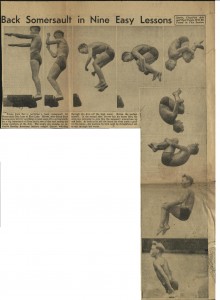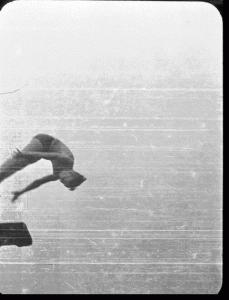The Curious, the Arcane: Discoveries in Special Collections
Every year the Library’s Special Collections and Archives Department adds new and exciting images to the digital archives available to researchers. As photograph collections are processed, unusual and unexpected items invariably are discovered. While going through the boxes that had held the Lane Brothers Photographic Archives assignment books, Special Collections and Archives staff discovered several rolls of 35 mm film that had escaped previous inventories. One of the film rolls shed light on the artistic career of Dan Lane, son of one of the commercial photographic company’s founding brothers. Lane published eight of the photos on the film in the July 30, 1939 issue of the Sunday American (Atlanta, Georgia), and 70 years later, Georgia State University student assistant Arthur Koch put the two items, newspaper clipping and film negative, together.
STOP-ACTION — MAGIC-EYE CAMERA

Dan Lane was not the first or the most famous photographer to use the stop-action camera. At the end of the 19th century, Eadweard Muybridge had experimented with stop-action photography to produce his monumental publications on animal locomotion and the human figure in motion. At the beginning, the stop-action camera was used for scientific purposes; later, for assistance in improving sports and work performance; and ultimately, as a resource for artists and the curious public. Because the stop-action camera produced a series of single shots, the resulting frames are clearer than they would have been had they been filmed with a motion-picture camera. The popularization in the 1930s and 1940s of the smaller Magic-Eye camera provided cameramen with a stop-action camera that could be more easily set up at photo-shoots — indeed, it could even be hand held. The year before Dan Lane published his “Back Somersault in Nine Easy Lessons,”Life magazine printed a four-page spread in its July 18, 1938 issue titled “Ralph Guldahl and the Magic Eye Show a Great Golfer’s Strokes” (p. 44-47).

Throughout the 19th century and into the early 20th century, there appeared many devices that would put still images into motion; stop-action stills were frequently “animated.” Dan Lane died in 1976, and it is not know if he ever saw his film of Jack Carver move. However, for student Arthur Koch, the temptation was too great. Arthur created this GIF before graduating from Georgia State University in December 2009.
Further reading:
SPECIAL COLLECTIONS AND ARCHIVES is located on the eighth floor of Library South. The department includes the University’s rare book collections, the internationally known Southern Labor Archives, Georgia State University’s Archives, Georgia Government Documentation Project, The Lane Brothers Photographic Company’s archives, the Tracy O’Neal Photographic Archives, the Atlanta Journal-Constitution Photographic Archives, Social Change archives and collections, Popular Music and Culture Collection, and the Women’s Collection.